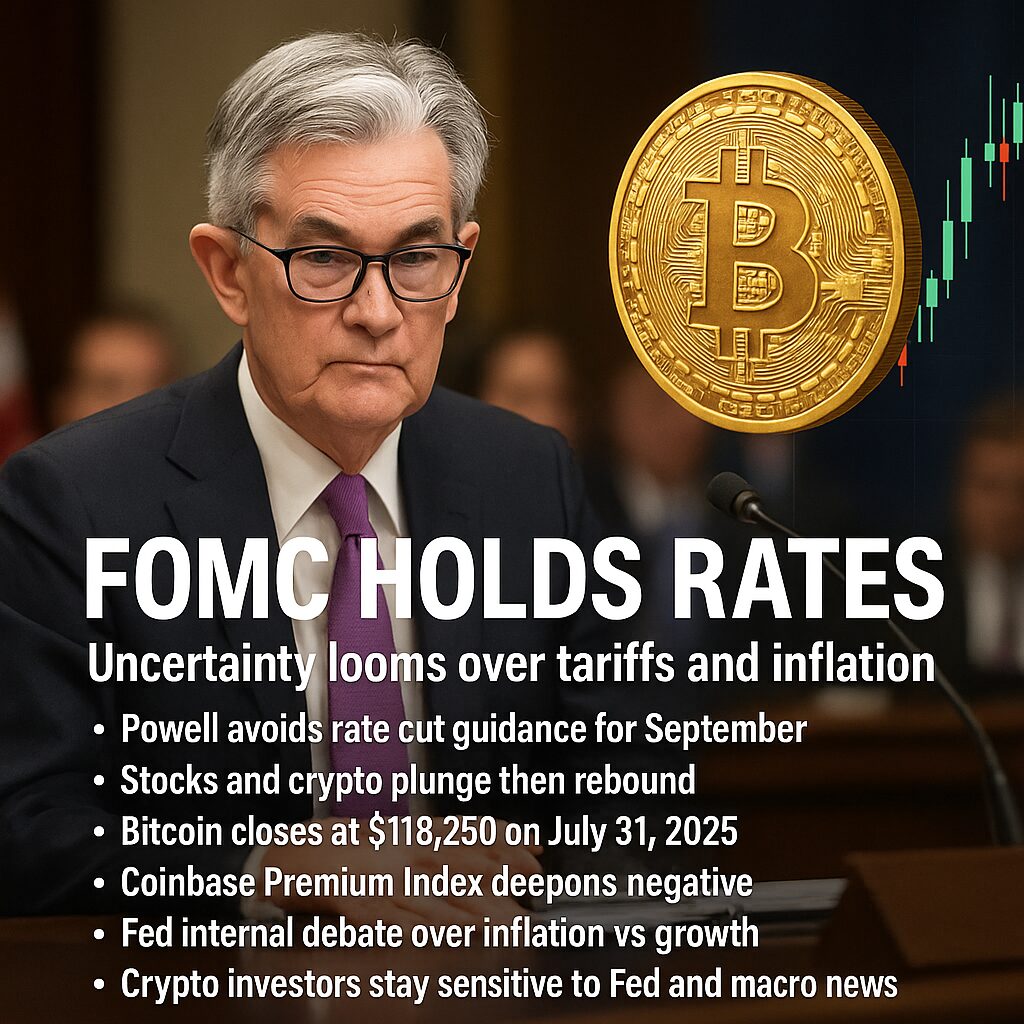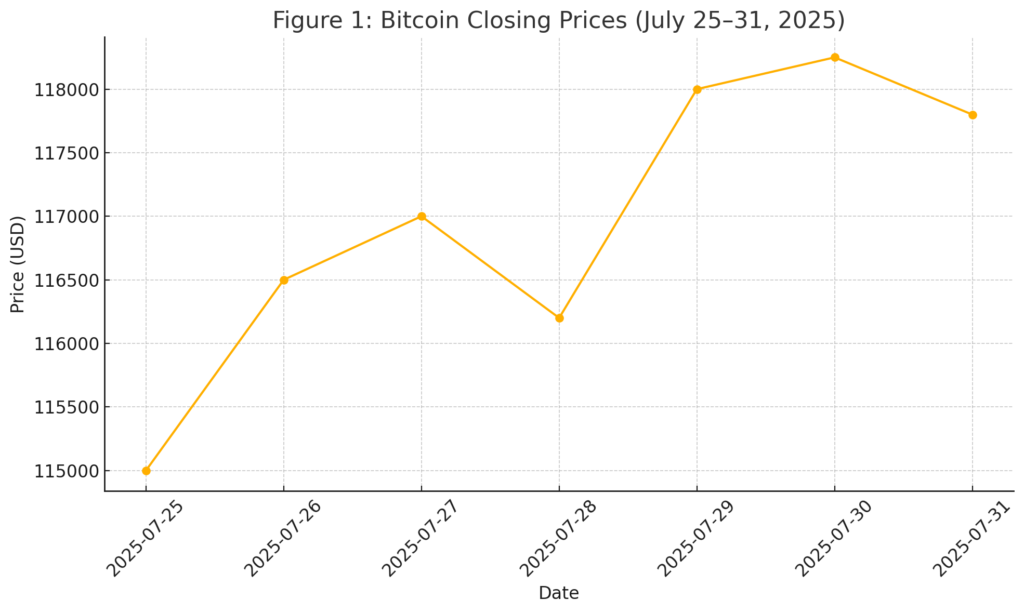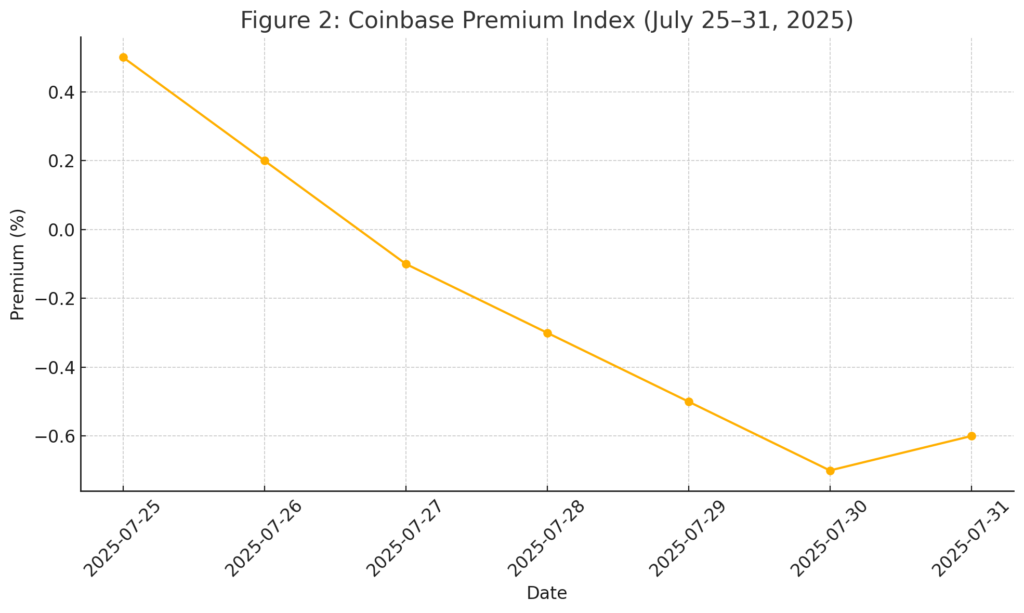
Main Points:
- FOMC maintains policy rate amid uncertain inflation and trade tensions
- Powell offers no commitment on September rate cuts, cooling market hopes
- Equity and crypto markets initially tumble before Bitcoin rebounds sharply
- Bitcoin closes at $118,250 on July 31, 2025, reflecting pronounced volatility
- Coinbase Premium index shifts deeper into negative territory, signaling waning U.S. institutional demand
- Divergent views within the Fed underscore debate over balance between inflation risks and growth support
- Crypto investors remain highly sensitive to Fed policy cues and macroeconomic developments
Introduction
On July 29–30, 2025, the U.S. Federal Open Market Committee (FOMC) chose to leave its benchmark federal funds rate unchanged, signaling that the current monetary policy stance remains appropriate given lingering uncertainties around tariffs and inflation. Fed Chair Jerome Powell’s explicit refusal to confirm a rate cut at the next meeting in September dashed market expectations, prompting swift sell-offs in both equity and cryptocurrency markets. Yet, Bitcoin’s dramatic rebound by Japanese morning hours highlighted the asset’s extreme sensitivity to Federal Reserve communications and the persistent volatility gripping crypto markets.
FOMC Decision: Context and Details
At the close of its two-day meeting, the FOMC reiterated its view that the existing interest rate is “well-positioned” to support economic growth while containing inflationary pressures. In response to questions about a potential rate cut in September, Chair Powell stated, “Nothing has been decided” — a clear departure from the markets’ forward-looking pricing, which had largely baked in a 25-basis-point reduction. This comment sent a chill through investors, leading to a rapid decline in major stock indices and an initial plunge in Bitcoin prices.
However, the Fed’s decision was not unanimous. Board Governors Michelle Bowman and Christopher Waller dissented, each advocating for a quarter-point cut, reflecting deep divisions within the committee over the trade-related inflation outlook. The debate centers on whether protectionist measures, including recent U.S. tariff hikes, will elevate consumer prices and if so, to what extent the Fed should counteract with looser monetary policy.
Powell’s Guidance and Market Reaction
Powell’s decision to decouple official policy statements from market expectations served as a stark reminder of the Fed’s independence. Traders had grown accustomed to dovish signals driving asset prices higher; this time, their assumptions were challenged. Equities initially sold off, with the S&P 500 down over 1% in afternoon trading. Bitcoin, which had tumbled alongside stocks, staged a remarkable late-night recovery, underscoring its status as both a risk asset and a lightning rod for sentiment swings.
Bitcoin Price Volatility
Over the week of July 25 to July 31, Bitcoin’s closing price ranged from approximately $115,000 to $118,250. Following Powell’s remarks on July 30, the price dipped below $117,000 before rebounding above $118,000 by July 31 morning in Tokyo. This whipsaw movement highlights the intraday sensitivity of crypto markets to macroeconomic news and Fed speak.
Figure 1: Bitcoin Closing Prices (July 25–31, 2025

Institutional Demand and Coinbase Premium
The Coinbase Premium index, which measures the price difference between Bitcoin quoted in USD on Coinbase and USDT-paired quotes on Binance, has slipped further into negative territory. Historically, a positive premium suggests strong U.S. institutional demand; its recent contraction indicates that institutional investors are retreating, possibly awaiting greater clarity on Fed policy.
(Insert Figure 2 here: Coinbase Premium Index chart)

Market participants view the premium’s decline as a barometer of U.S. demand, and its movement has increasingly driven short-term price trends.
Macro Uncertainties and Crypto Sensitivity
With global growth projections being continuously revised and trade policy still in flux, investors across asset classes are bracing for heightened volatility. Cryptocurrencies, lacking the fundamental valuation anchors of traditional markets, react even more sharply to shifts in interest-rate outlooks and risk sentiment. As long as the Fed maintains a cautious tone, expect continued choppy trading conditions for Bitcoin and its peers.
Recent Trends and Emerging Themes
- Altcoin ETP Prospect: Following the FOMC decision, speculation has grown around potential approval of altcoin exchange-traded products (ETPs). Market insiders suggest that Ethereum and Solana ETP applications are under review by the SEC, which could reshape institutional flows.
- On-Chain Liquidity Metrics: Data shows a retreat in exchange inflows and an increase in on-chain accumulation, hinting that long-term holders are absorbing supply.
- Options Market Positioning: Open interest in Bitcoin call options for strikes above $125,000 has risen, indicating that derivatives traders are positioning for a breakout despite short-term headwinds.
Conclusion
The FOMC’s decision to hold rates and Powell’s guarded commentary have reaffirmed the fragility of risk-based assets, particularly cryptocurrencies. Bitcoin’s rollercoaster ride—itself a microcosm of broader market sentiment—underscores the need for investors to stay attuned to central-bank discourse and macro data releases. While the path for Fed policy remains uncertain, savvy crypto market participants can leverage volatility through strategic entry points, derivative hedging, and a focus on long-term on-chain indicators.

